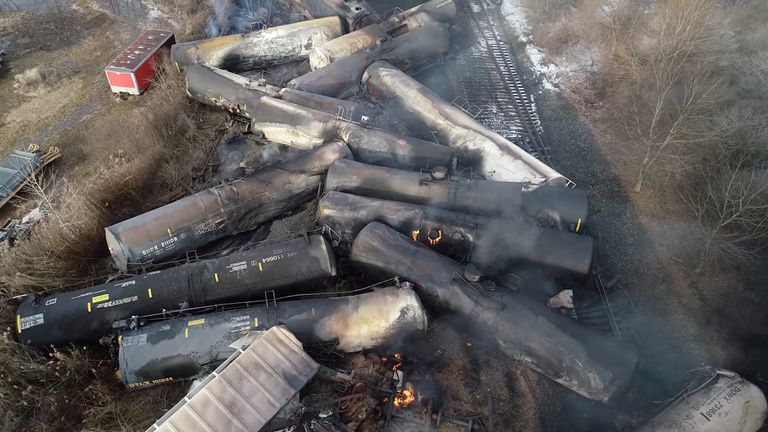More Transparency Needed Regarding Murky Ohio Chemical Spill
Though the plumes of toxic black smoke engulfing a small Ohio town have dissipated, much about the incident still remains unclear. Now being named the biggest natural disaster in the United States, the Ohio train derailment that took place in early February is still far from resolution due to insufficient transparency from officials.
On Feb. 3, a Norfolk Southern train traveling from Madison, Ill., to Conway, Pa., derailed in East Palestine, Ohio, resulting in a hazardous chemical spill and widespread fire. The small town of East Palestine, located on the Ohio and Pennsylvania border, was engulfed in smoke.
The derailed train cars carried a variety of toxic chemicals, posing an imminent threat to those living in the surrounding areas of the spill. Fears of an explosion resulted in a mandatory evacuation on Feb. 6, with Ohio Gov. Mike Dewine telling residents that leaving was a “matter of life and death.” While residents who evacuated were cleared to return to their homes on Feb. 8, the effects of the derailment appear to still be persistent.
The way that Ohio state officials, Norfolk Southern and the Environmental Protection Agency (EPA) have handled the situation thus far is abysmal. Not only is their lack of transparency suspicious, but it’s life-threatening. Far too much time has gone by for residents to still have burning questions, waiting on answers and worried for their lives.
A month has passed since the incident and officials have reassured residents that the area is cleared for safety, however, not everyone is convinced. Many residents within the vicinity of the chemical spill have reported symptoms of exposure such as nausea, headaches, burning sensations in the eyes and a lingering smell of chlorine in the air.
Among the chemicals that spilled were thousands of pounds of vinyl chloride, which is colorless, highly flammable and has been linked to liver cancer, leukemia and lung cancer. When vinyl chloride catches on fire, it can produce hydrochloric acid and phosgene gas, which was commonly used as a choking agent in World War I.
Short-term effects of exposure to the chemicals spilled include dizziness, shortness of breath, coughing, nausea, drowsiness, burning in the skin and eyes, hospitalization and even death. When dealing with such dangerous substances, it is imperative that law enforcement communicate their findings to residents to the fullest extent possible.
Norfolk Southern — the company of the train that derailed — is currently being sued by local business owners under the argument that it “failed to exercise reasonable care to protect local residents who were exposed to toxic substances.” It’s time for Norfolk Southern, as well as Ohio state officials and the EPA, to face the public and address their concerns.
Another concern is the fact that this spill has contaminated water in the Ohio River, which is connected to Illinois, Indiana, Kentucky, Pennsylvania and West Virginia, and it is a source of drinking water for many Americans. In the weeks following the incident, Ohio residents noticed the river bubbling with the appearance of an oil slick. Some residents took to social media to show fogginess and film in their tap water, deemed safe for consumption by the EPA. It is estimated that over 43,000 fish have died as a result of the chemical spill, causing many to feel skeptical on how transparent the EPA and Ohio state officials really are. It seems rather suspicious that within just two days, residents were cleared to re-enter the area as if nothing had happened.
In an interview with Purdue University professor Andrew J. Whelton, he explained that “state, federal, and local officials haven’t been forthright and transparent enough with the population.” When the incident first occurred, it took nine days for officials to reveal the contents of the train cars to the public. Lives depend on the information released from these officials, and their response time and communication effort has been despicable.
Whelton also mentioned that drinking water test results have not been made available, and thousands of other chemicals may have been created when the initial ones were burnt. He stressed the fact that none of these chemicals are meant for human exposure, and that both the Ohio government and Norfolk Southern must take initiative and answer the many questions that have been raised.
The best course of action is for Ohio officials, Norfolk Southern and the EPA to answer these questions explicitly with proof. By focusing more effort on public relations, education and data, these organizations can help remedy the public hysteria caused by their lack of communication.
First, public hearings need to be held with representatives from each organization. That way, the communities that have been directly affected can voice their concerns and have their questions answered in real time. For the broader public, a press conference must be held, and representatives must be trained to answer each question in a clear and specific manner.
These organizations must also take the initiative to educate the public about this disaster. This can be done through utilizing websites, social media or even helplines to report concerns. It is their responsibility to inform the public about the long-term effects of exposure, treatment recommendations and how to take the proper precautions.
The last component is data transparency. They need to create an area, such as a website, where all of the results from safety tests can be publicized. Residents are still waiting to find actual results from drinking water and soil tests, and they have a right to see for themselves that they are no longer in danger.
In any crisis, clear and quick communication is critical to ensure the safety of those it has affected. The Ohio state officials, along with Norfolk Southern and the EPA, must take initiative and be transparent with their findings. Lives depend on the answers that they can provide, and by remaining silent, they keep thousands of people in the dark.
Ava Carreiro, GSB ’24, is a marketing major from New Providence, N.J.
Ava Carreiro is a senior from New Providence, N. J., majoring in marketing. She began her time at the Ram in fall 2021, served as Digital Producer for...













































































































































































































